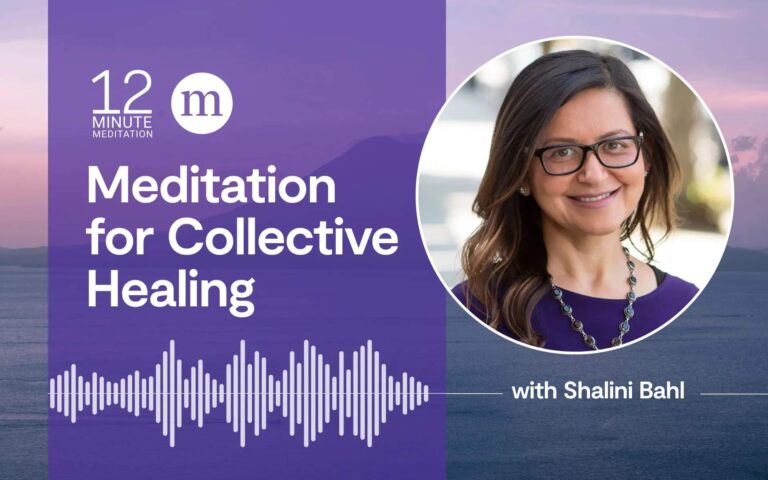This guided practice focuses on healing together, shaped by our personal experiences, fears, and aspirations.
Main Takeaways:
- The practice of deep understanding can assist us in discovering common ground with those who appear different from us.
- This meditation highlights that, despite our differences, we are all influenced by our individual experiences, fears, and aspirations.
- By contemplating our shared experiences and humanity, we can gain a better understanding of others and take thoughtful steps toward collective healing.
In our world today, which is both connected and yet starkly divided, achieving mutual understanding goes beyond mere good intentions. True connection and healing require the development of a more profound understanding. The goal isn’t to erase differences but to create connections that span those differences.
This gentle yet impactful meditation led by Shalini Bahl reveals how our experiences, fears, and hopes shape us all. Gaining deep understanding is akin to exploring beneath the bright surface into deeper waters. By recognizing what is evident and what lies deeper, we can begin to shift our usual patterns, making decisions rooted in authentic wisdom instead of reactive tendencies.
Meditation for Collective Healing
- Today’s practice involves three main steps. First, we will return to a state of non-judgmental awareness; next, we will listen for deeper understanding; finally, we will begin to take mindful actions.
- Let’s begin by taking a few moments to pause and return to our state of non-judgmental awareness. Find a comfortable seated position, elongating your spine. Lift your shoulders gently up, back, and down so that your breath can flow freely. Ground yourself by feeling the support beneath your feet.
- You may close your eyes or lower your gaze. Focus on your breath and observe its natural rhythm as it flows in and out. Allow it to be deep if it feels deep, or shallow if it feels shallow. Invite your mind to be present with your breath and body. If preferred, let your focus rest on your heart area, feeling the expansion in your chest with each inhale and a soft release with each exhale.
- Gently bring to mind a situation that is causing tension or conflict. Visualize it clearly as if observing from a slight distance. Pay attention to your body’s reactions. You may feel tightness in your chest or abdomen, or your breathing may become quick. Notice these sensations kindly, recognizing that they rise and fade within your body. Allow space for all sensations and emotions—be it grief, anger, or sadness—to exist without trying to change or hide them.
- Next, observe the thoughts that accompany these emotions. Think about the individuals involved—how they look, their words, their tone. Imagine your mind as a vast sky where all arising thoughts drift by like clouds.
- Once you feel a bit more spaciousness in your mind and body, move to the next phase: deep listening. Set an intention to understand not only your own experiences and needs but also to extend that same understanding to others involved.
- If you need assistance in achieving this deep listening state, consider exploring these reflective questions. If you require more time, feel free to pause the recording or write in a journal. Start with, What are your essential needs in this situation? You may be seeking safety, recognition, a healthy atmosphere, or respect for your beliefs.
- Next, ponder our common humanity with others. Silently think, Like me, this person desires happiness and good health. Like me, this individual cares for their family. Continue reflecting in this manner, identifying similarities with the other person(s). Like me…
- From this place of connection, consider what their lived experiences might contribute to their current perspective or actions. What assumptions or beliefs are influencing my view in this situation?
- Keep breathing deeply to foster more space in your mind and body. Exhale any tensions you might be holding on to. What other possibilities exist here? There’s no need to force answers; simply trust your intention for deeper understanding and recognition of our shared humanity, knowing that clarity will come from within.
- You may pause the recording to take a mindful walk outdoors or journal to allow for deeper insights. As clarity develops, you might notice a release of strain—perhaps a subtle shift in your posture or your breath becoming calmer and more profound.
- From this place of connection, reflect on the final step: contemplating how to take intentional, mindful action. Consider small steps you can take to foster greater understanding and harmony in this situation. Let this intention extend beyond the specific scenario. For instance, how do your choices around consumption—what you eat, where you source your products—align with your intentions and values?
- Remember, this practice is available to you at any time, where you can revisit these three steps: return to your non-judgmental awareness, seek deeper understanding, and take mindful actions. Let’s take one last deep breath together. As we slowly exhale, may this practice benefit us and all beings.


